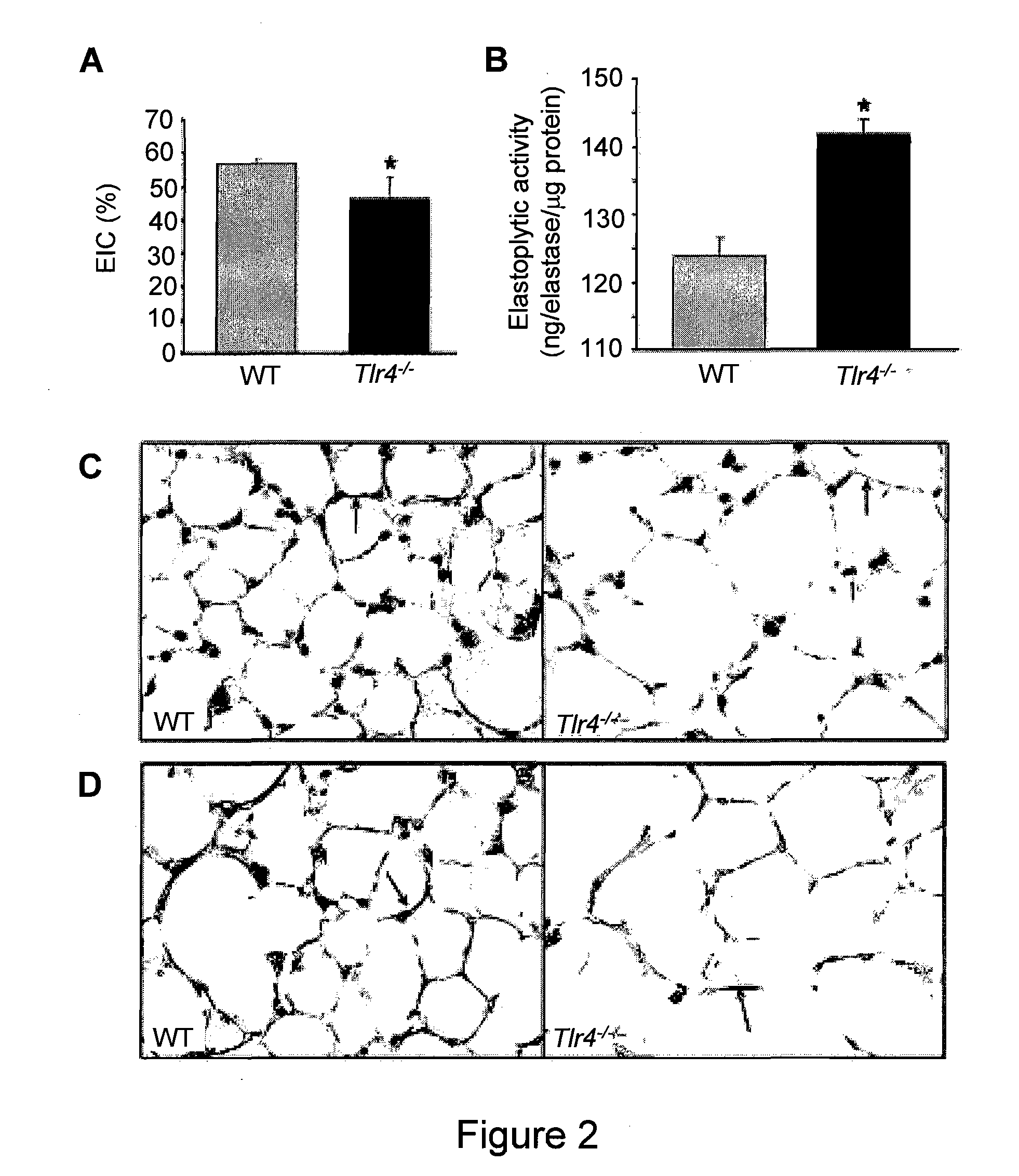Toll-LIke Receptor 4 Deficiency and Downstream Effectors Cause Pulmonary Emphysema
a technology of toll-like receptor and downstream effector, which is applied in the direction of genetic material ingredients, instruments, antibody medical ingredients, etc., can solve the problems of oxidative stress and achieve the effects of reducing cathepsin e expression, and increasing cathepsin e expression
- Summary
- Abstract
- Description
- Claims
- Application Information
AI Technical Summary
Benefits of technology
Problems solved by technology
Method used
Image
Examples
experimental examples
[0316]The invention is further described in detail by reference to the following experimental examples. These examples are provided for purposes of illustration only, and are not intended to be limiting unless otherwise specified. Thus, the invention should in no way be construed as being limited to the following examples, but rather, should be construed to encompass any and all variations which become evident as a result of the teaching provided herein.
[0317]The materials and methods employed in the experiments disclosed herein are now described.
Generation of Transgenic Constructs and Mice:
A. TLR4-Deficient
[0318]Tlr4− / − and MyD88− / − mice have been previously described (Zhang X., et al., 2005, J. Immunol. 175:4834-4838; Adachi O., et al., 1998, Immunity. 9:143-150; Hoshino K., et al., 1999, J. Immunol. 162:3749-3752). TLR4-deficient mouse lines C3H / HeJ and C57BL / 10ScNJ and their respective controls were purchased from The Jackson Laboratory. C57BL / 6J Tlr4− / − mice were generated afte...
experimental example 1
TLR4 and MyD88 Deficiencies Result in Emphysema
[0352]The role of TLR4 in conditions of ambient oxygen were investigated by examining the lungs of Tlr4− / − mice in an unchallenged state. There were no differences between the lungs of WT and Tlr4− / − mice at 1 and 2 months of age, but by 3 months Tlr4− / − mice showed significantly increased lung volumes (FIG. 1A). Emphysema progressed and appeared to peak between 6 months and 1 year of age. There were no differences between the body weights of WT and Tlr4− / − mice at 1, 3, 6, and 12 months of age. Histologic evaluation revealed enlargement of the air spaces distal to the terminal bronchioles accompanied by destruction of the normal alveolar architecture in Tlr4− / − mice, characteristic of emphysema (FIG. 1B). Morphometric quantitation of the airspace enlargement revealed increased chord lengths in Tlr4− / − mice (FIG. 1C). Using 3 months of age as a representative time point, data were confirmed in different strains of TLR4-deficient mice, i...
experimental example 2
TLR4-Deficient Mice Show Decreased Elastase Inhibitory Capacity
[0354]A protease / antiprotease imbalance leading to the breakdown of lung elastin is thought to play a key role in the pathogenesis of pulmonary emphysema. Therefore, antiprotease activity was quantitated by measuring the elastase inhibitory activity in BAL and serum of Tlr4− / − and WT mice. Tlr4− / − mice showed a marked decrease in their elastase inhibitory capacity (EIC) in BAL (FIG. 2A), as well as in serum (data not shown), compared with WT mice. The presence of elastolytic activity in the lung lysates of Tlr4− / − mice was also assayed. Markedly increased elastolytic activity was found in Tlr4− / − mice compared with WT mice (FIG. 2B). Similar results were also found in BAL (data not shown). The relationship between decreased elastase inhibitory activity and increased elastolytic activity was examined in the lungs of Tlr4− / − mice to determine if decreased elastase inhibitory activity led to the destruction of elastin-conta...
PUM
| Property | Measurement | Unit |
|---|---|---|
| pH | aaaaa | aaaaa |
| pH | aaaaa | aaaaa |
| pH | aaaaa | aaaaa |
Abstract
Description
Claims
Application Information
 Login to View More
Login to View More - R&D
- Intellectual Property
- Life Sciences
- Materials
- Tech Scout
- Unparalleled Data Quality
- Higher Quality Content
- 60% Fewer Hallucinations
Browse by: Latest US Patents, China's latest patents, Technical Efficacy Thesaurus, Application Domain, Technology Topic, Popular Technical Reports.
© 2025 PatSnap. All rights reserved.Legal|Privacy policy|Modern Slavery Act Transparency Statement|Sitemap|About US| Contact US: help@patsnap.com



